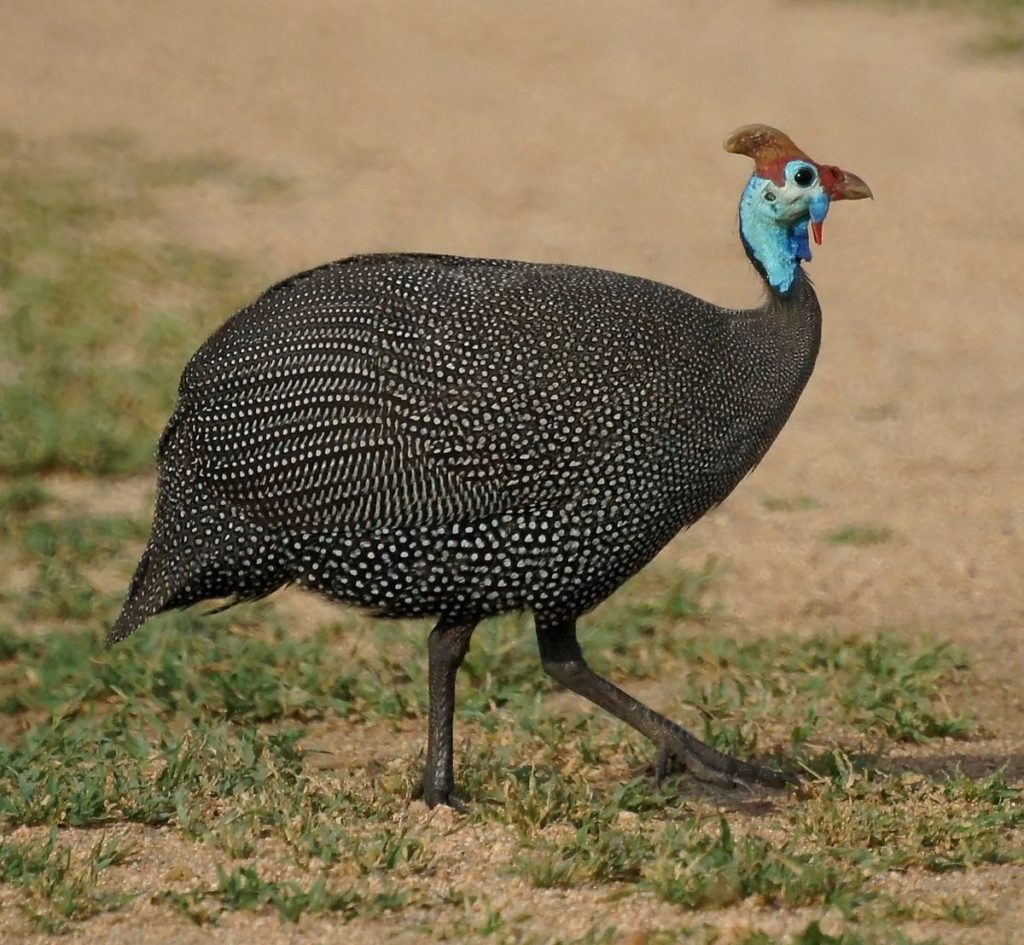Birdfinding.info ⇒ The most numerous and widespread form of Helmeted Guineafowl is generally common across much of eastern and southern Africa. It is especially common and readily observed (often “park-tame”) in major protected areas such as: in Namibia, Etosha National Park; in Botswana, Moremi Game Reserve and Chobe Flood Plains; the Victoria Falls area; and in South Africa, Kruger, Table Mountain, and West Coast National Parks.
“Tufted Guineafowl”
Numida meleagris mitratus
Southern Africa: savannas, brushlands, and various open and semiopen habitats, from central Angola, eastern D.R. Congo, Rwanda, and central Kenya south to east-central Namibia and northern and eastern South Africa.
Introduced across other parts of South Africa south and west to Cape Town, and much of central and southern Madagascar.
Identification
A typical guineafowl: deep-bodied with a long, thin neck and small, mostly unfeathered head. The body and wings are blackish and densely covered with white spots throughout.
“Tufted” can be distinguished from other forms of Helmeted Guineafowl by the color and shape of its bare parts: aqua-blue skin on the face and down the sides of the neck; deep-blue-to-purplish throat-wattles; thin wattles on the cheeks that are blue with red tips; and an irregularly shaped and textured casque that is brownish at the top and usually deep red around its base.

“Tufted Guineafowl,” N. m. mitratus. (Addo National Park, Eastern Cape, South Africa; August 30, 2019.) © copper

“Tufted Guineafowl,” N. m. mitratus. (Camdeboo National Park, Eastern Cape, South Africa; December 21, 2019.) © Karin Coetzer

“Tufted Guineafowl,” N. m. mitratus, with extremely thin cheek-wattles. (Mana Pools National Park, Zimbabwe; May 16, 2019.) © Shirley Hitschmann
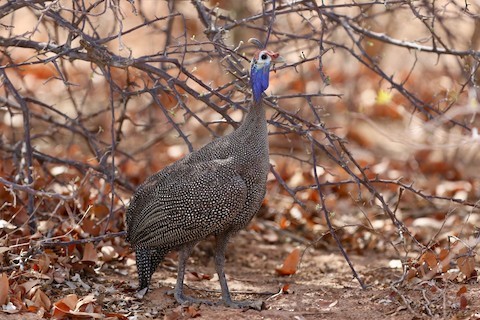
“Tufted Guineafowl,” N. m. papillosus. (Etosha National Park, Namibia; November 14, 2019.) © Krista Oswald

“Tufted Guineafowl,” N. m. mitratus. (Mana Pools National Park, Zimbabwe; May 16, 2019.) © Shirley Hitschmann
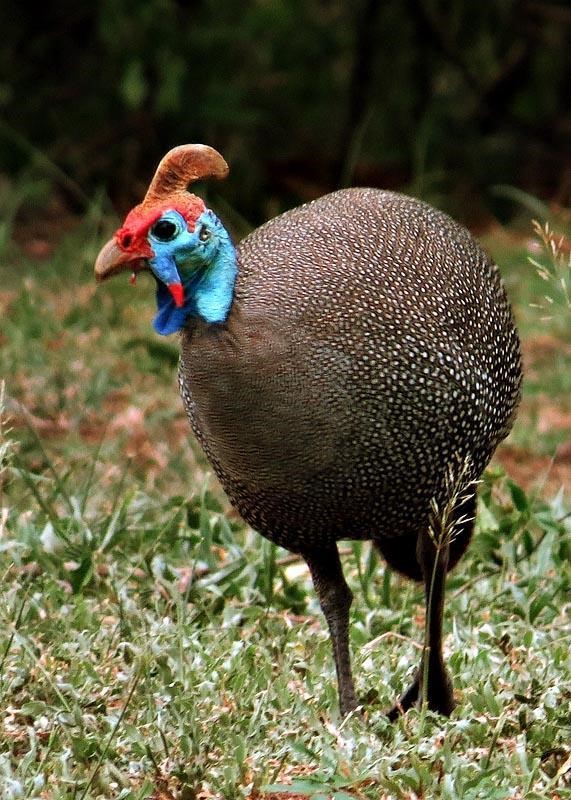
“Tufted Guineafowl,” N. m. coronatus. (Mlawula Nature Reserve, Lubombo, Eswatini; December 27, 2015.) © Kate Braun

“Tufted Guineafowl,” N. m. papillosus. (Walvis Bay, Erongo, Namibia; January 18, 2019.) © Rogério Rodrigues
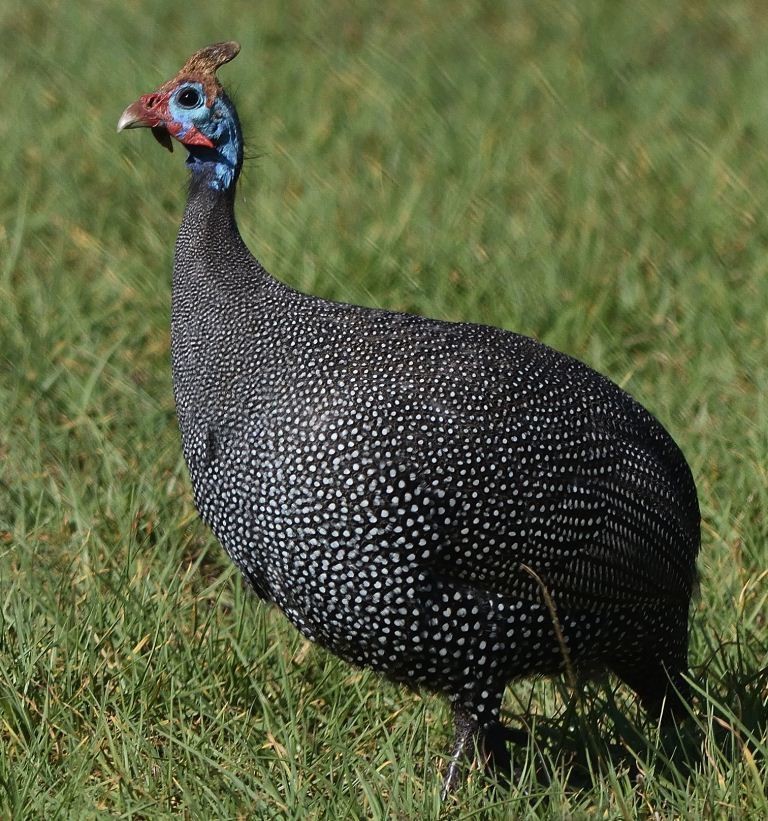
“Tufted Guineafowl,” N. m. mitratus. (Doordekraal Dam, Bellville, Western Cape, South Africa; April 27, 2019.) © Gerald Wingate
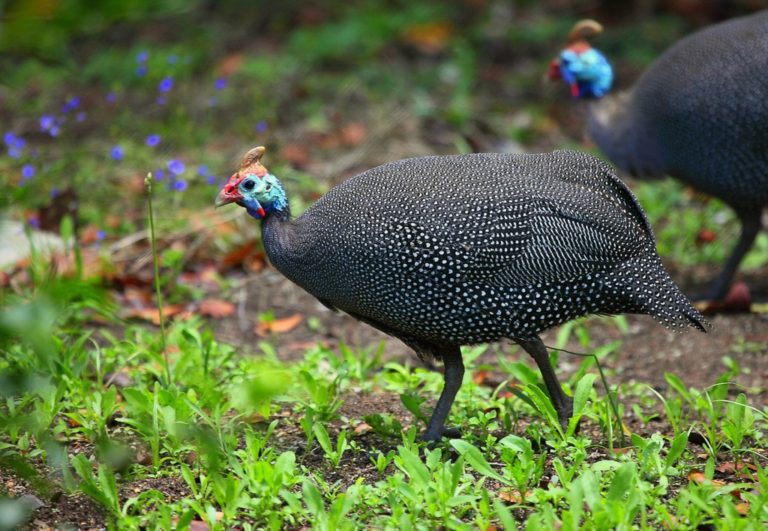
“Tufted Guineafowl,” N. m. mitratus. (Kirstenbosch Botanical Garden, Cape Town, South Africa; November 23, 2010.) © Carmelo Lopez
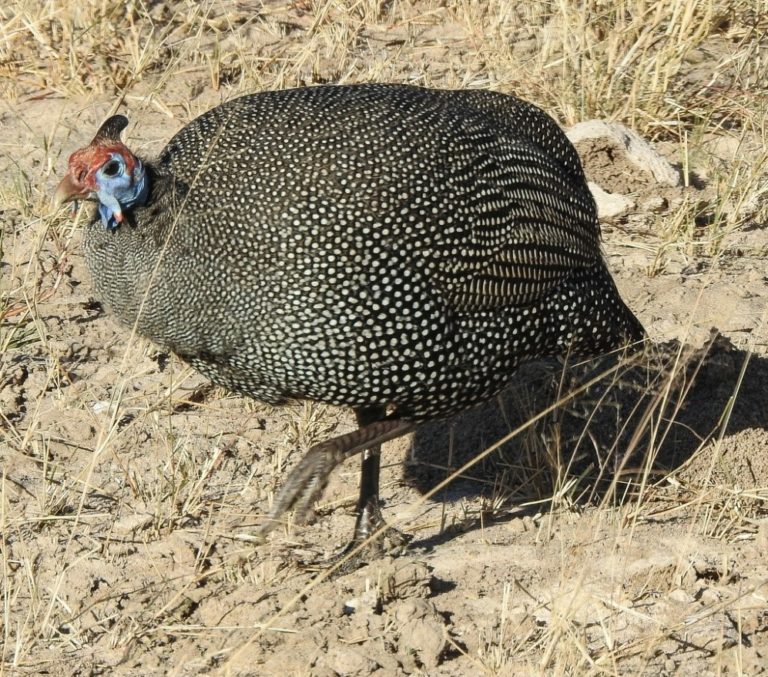
“Tufted Guineafowl,” N. m. mitratus—note tiny red tip on cheek-wattle. (Hwange National Park, Zimbabwe; May 27, 2019.) © supergan
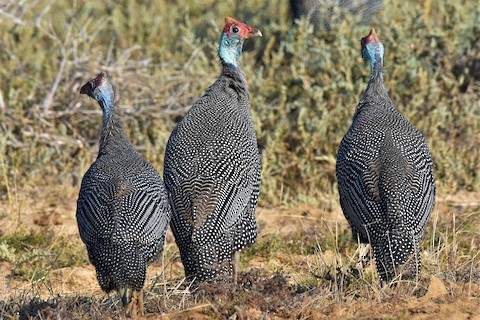
“Tufted Guineafowl,” N. m. mitratus. (Tsimanampetsotsa Nature Reserve, Madagascar; August 10, 2019.) © Fabien Quétier

“Tufted Guineafowl,” N. m. mitratus. (Chikwawa, Malawi; May 4, 2019.) © lemoncul
The bare parts of the head and neck are highly variable in color and texture (often resembling a half-melted candle), but consistently include red-tipped cheek-wattles and a red base around the irregularly-shaped casque.
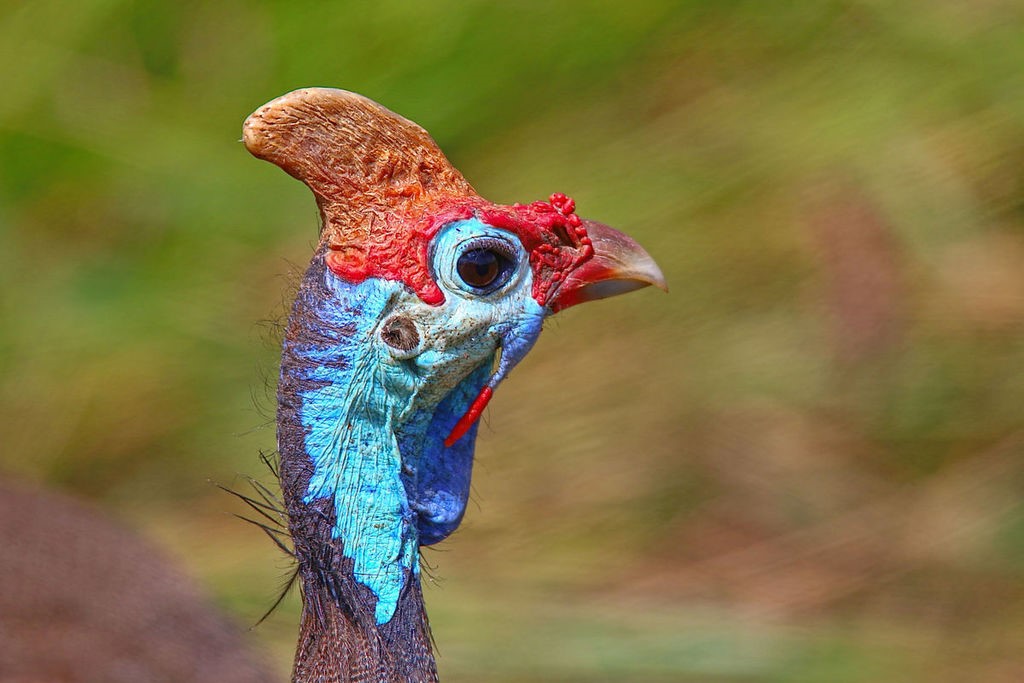
“Tufted Guineafowl,” N. m. mitratus, showing colorful, irregular head ornamentation—note extremely thin, needle-like cheek-wattles. (Rietvallei, Pretoria, South Africa; March 9, 2017.) © tjeerd
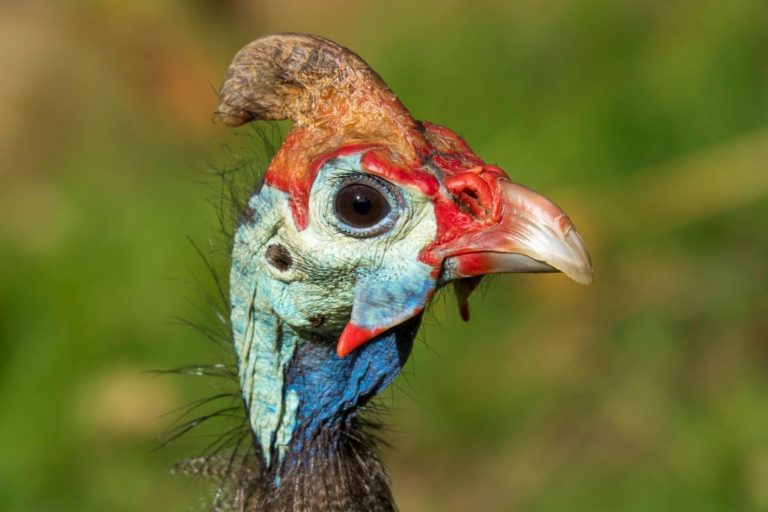
“Tufted Guineafowl,” N. m. mitratus—note broad-based, tapered cheek-wattles. (Table Mountain National Park, Western Cape, South Africa; September 30, 2019.) © Kris Decleer
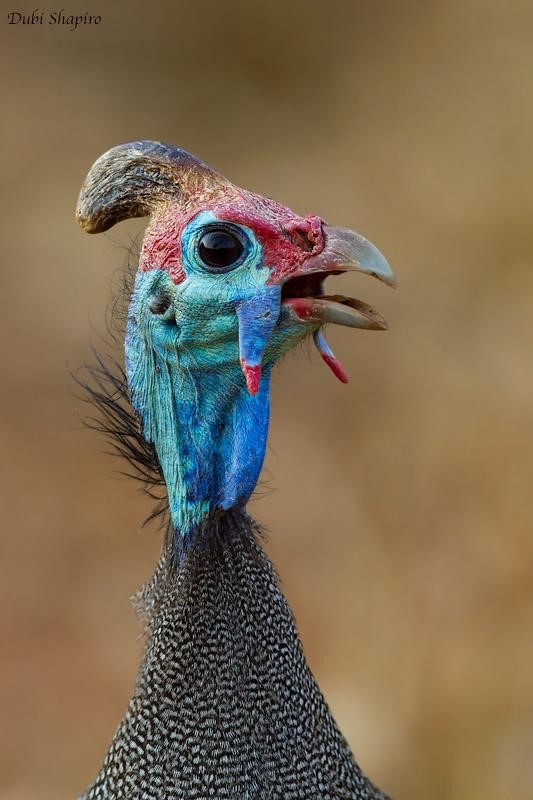
“Tufted Guineafowl,” N. m. mitratus, with small red tips on cheek-wattles. (Kruger National Park, South Africa; October 2, 2010.) © Dubi Shapiro
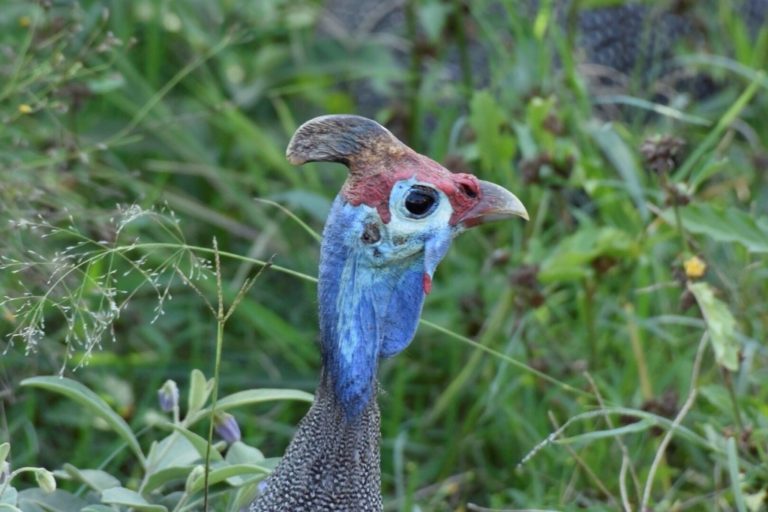
“Tufted Guineafowl,” N. m. mitratus. (Pilanesberg National Park, North West, South Africa; April 18, 2019.) © tjarko

“Tufted Guineafowl,” N. m. papillosus. (Sunday Pan, Central Kalahari Game Reserve, Botswana; March 31, 2013.) © Barbara Schneider

“Tufted Guineafowl,” N. m. mitratus, showing deep-blue throat-wattle. (Kruger National Park, South Africa; April 18, 2019.) © Guenther Karmann

“Tufted Guineafowl,” N. m. mitratus, showing deep-blue throat-wattle. (Kruger National Park, South Africa; November 30, 2016.) © Bernard DuPont

“Tufted Guineafowl,” N. m. mitratus. (Farleigh, Western Cape, South Africa; September 12, 2018.) © Colin Ralston
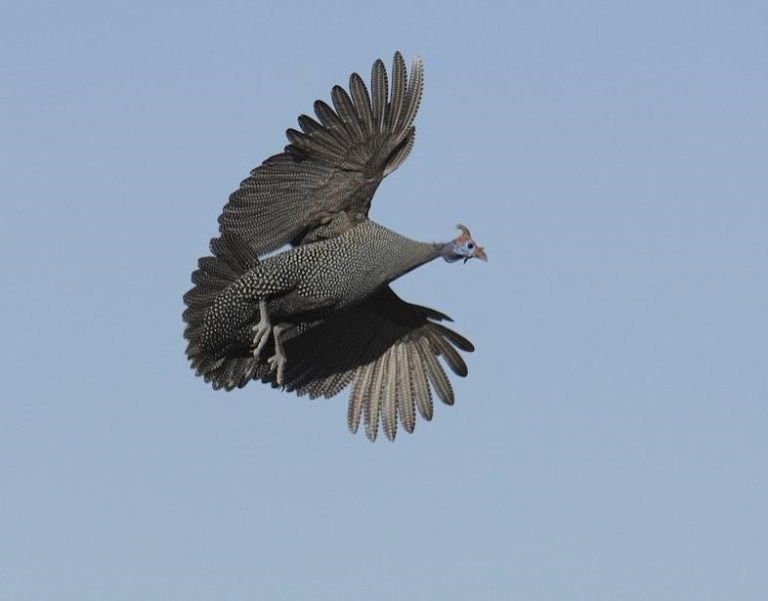
“Tufted Guineafowl,” N. m. papillosus, in flight. (Chobe National Park, Botswana; September 20, 2010.) © Gunnar Pettersson

“Tufted Guineafowl,” N. m. papillosus, immature, ventral view. (Sunday Pan, Central Kalahari Game Reserve, Botswana; March 31, 2013.) © Barbara Schneider
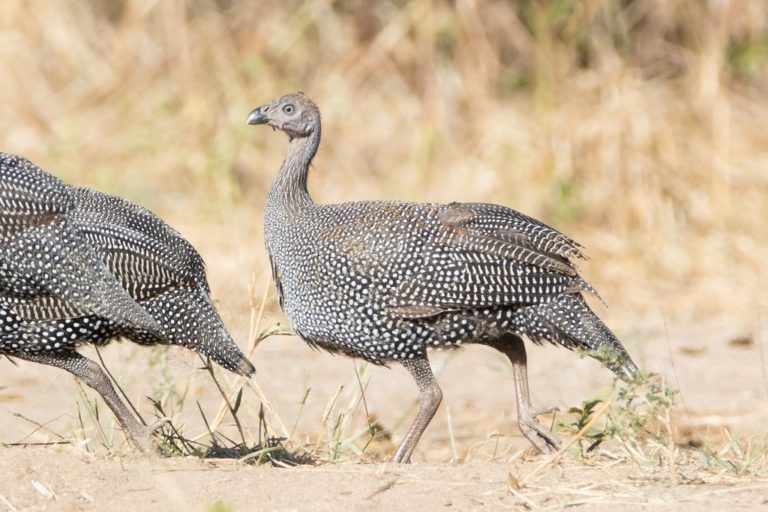
“Tufted Guineafowl,” N. m. mitratus, immature. (Mana Pools National Park, Zimbabwe; May 16, 2019.) © Shirley Hitschmann

“Tufted Guineafowl,” N. m. mitratus, immature. (Wilderness National Park, Western Cape, South Africa; April 29, 2018.) © Callum Evans
Cf. Other Helmeted Guineafowl. The forms of Helmeted Guineafowl are usually distinguishable based on the color and shape of the bare parts—although there is some internal variation within each form, as well as hybridization and some degree of apparent intergradation.
“Moroccan” has a small brown casque with elongated, upward-pointing feathers on the back of the head, whitish facial skinwhitish facial skin, and a “handlebar moustache” that consists of a long, broad, curled red wattle on each cheek, and a fleshy red connection across the cere.
“West African” has a small brown casque, whitish facial skin, and a “handlebar moustache” that consists of a long, broad, curled red wattle on each cheek, and a fleshy red connection across the cere.
“Ethiopian” has a small-to-medium-sized brown casque, bluish facial skin, and a cluster of bristles on the cere.
“Reichenow’s” has a very tall orange-brown casque, turquoise facial and neck skin, a black dewlap, and a “handlebar moustache” that consists of a long, broad, curled red wattle on each cheek, and a fleshy red connection across the cere.
“Tufted” has a tall orange-brown casque with a red base, red cere, turquoise facial and neck skin, a dark-blue or violet dewlap, and long, thin, pointed cheek-wattles that are bluish with red tips.
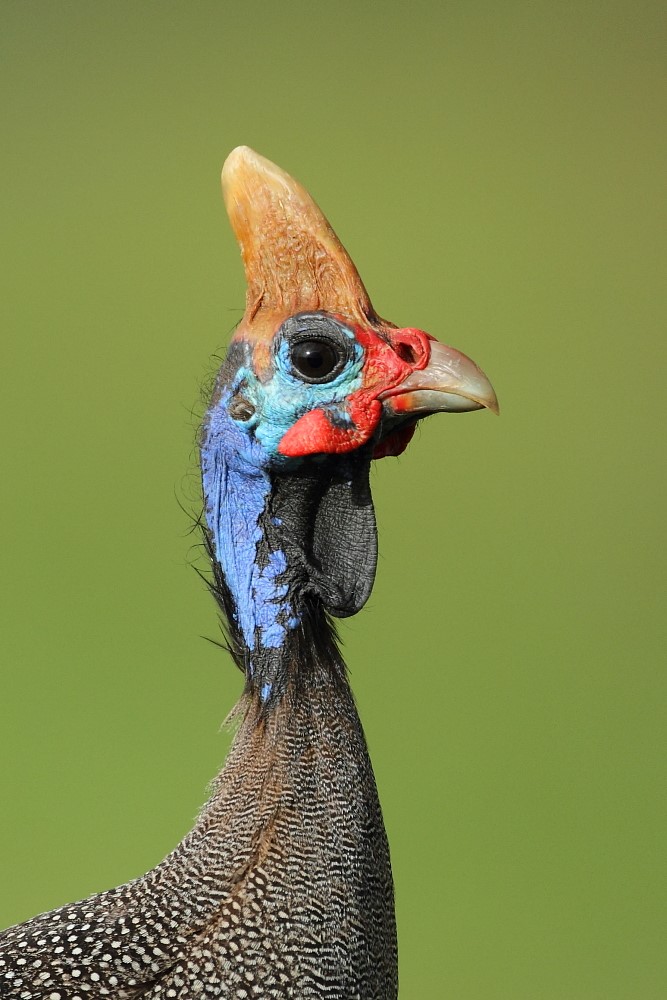
“Reichenow’s Guineafowl,” N. m. reichenowi, the champion of helmets, showing its distinctively tall orange-brown casque, red caruncles, turquoise cheeks, purplish neck-skin, and black dewlap. (Tarangire National Park, Tanzania; February 2, 2013.) © Darran Rickards
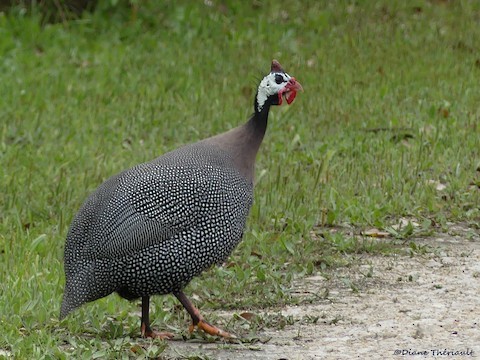
“West African Guineafowl,” N. m. galeatus, showing distinctive white facial skin, small casque, and red “handlebar moustache.” (Goose Island State Park, Texas; April 1, 2019.) © Diane Thériault
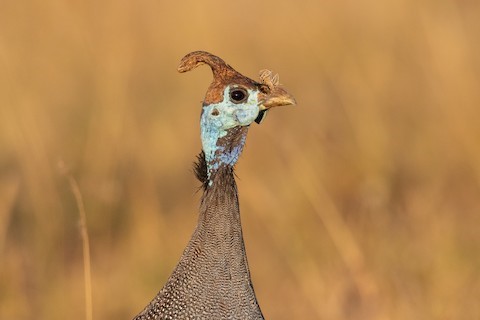
“Ethiopian Guineafowl,” N. m. meleagris, showing its small brown casque, bluish facial skin, and cluster of bristles on the cere. (Yabello, Oromia, Ethiopia; December 30, 2019.) © Stefan Hirsch

“Tufted Guineafowl,” N. m. mitratus, showing its orange-brown casque with a red base, red cere, turquoise facial and neck skin, a dark-blue dewlap, and long, thin cheek-wattles that are bluish with red tips. (Kruger National Park, South Africa; April 18, 2019.) © Guenther Karmann
Notes
Polytypic form consisting of four recognized subspecies. One of five potentially distinct forms of Helmeted Guineafowl (Numida meleagris). See Frontiers of Taxonomy: The Many-Helmeted Guineafowl, an Awkward Foursome.
References
BirdLife International. 2018. Numida meleagris. The IUCN Red List of Threatened Species 2018: e.T22679555A132052202. https://dx.doi.org/10.2305/IUCN.UK.2018-2.RLTS.T22679555A132052202.en. (Accessed April 15, 2020.)
eBird. 2020. eBird: An online database of bird distribution and abundance. Cornell Lab of Ornithology, Ithaca, N.Y. http://www.ebird.org. (Accessed April 15, 2020.)
Madge, S., and P.J.K. McGowan. 2002. Pheasants, Partridges, and Grouse: A Guide to the Pheasants, Partridges, Quails, Grouse, Guineafowl, Buttonquails, and Sandgrouse of the World. Princeton University Press, Princeton, N.J.
Martínez, I., and G.M. Kirwan. 2020. Helmeted Guineafowl (Numida meleagris). In Handbook of the Birds of the World Alive (J. del Hoyo, A. Elliott, J. Sargatal, D.A. Christie, and E. de Juana, eds.). Lynx Edicions, Barcelona. https://www.hbw.com/node/53526. (Accessed April 15, 2020.)
Sinclair, I., P. Hockey, W. Tarboton, and P. Ryan. 2011. Birds of Southern Africa (Fourth Edition). Random House Struik (Pty) Ltd. Cape Town, South Africa.
van Perlo, B. 2002. Birds of Western and Central Africa. Princeton University Press, Princeton, N.J.
Xeno-Canto. 2020. Helmeted Guineafowl – Numida meleagris. https://www.xeno-canto.org/species/Numida-meleagris. (Accessed April 15, 2020.)
